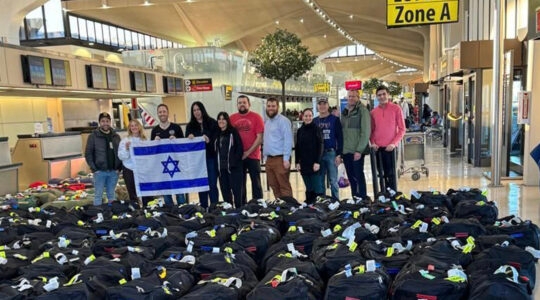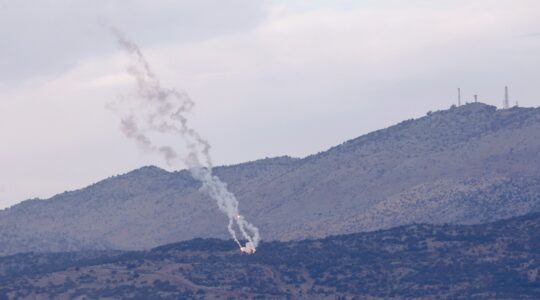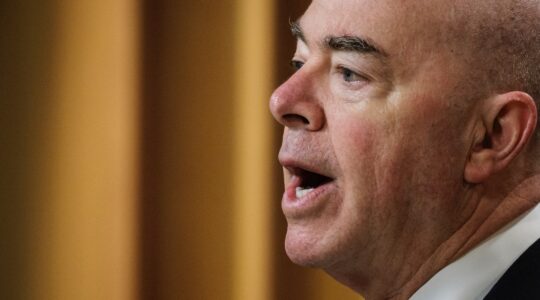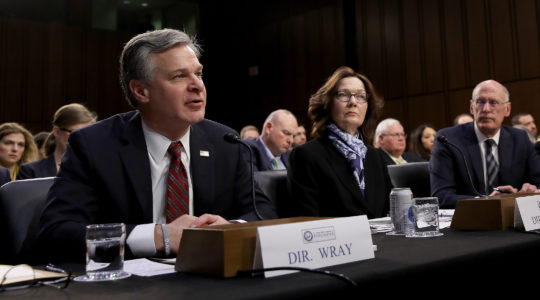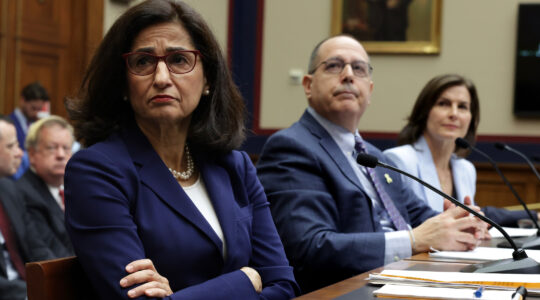MILFORD, Pa. (JTA) – In a hilly corner of northeastern Pennsylvania, someone recites the motzi into a microphone as sweaty children race late into the covered dining hall, joining their friends at long tables as lightweight screen doors slam behind them. The walls of the barn-like building are decorated with posters from color wars past, teams with names like Dreidels of the Lost Ark, Willy Wonka and the Matzah Factory, and the most recent edition, Harry Potter and the Search for Kabbalah, whose members are now likely in college or beyond.
Once the kids have jostled into line, gobbled their macaroni and cheese, fruit and ice cream and discussed the gossip of the day, they wait for some favorite counselors to approach the microphone again, this time with guitars. Then, the room bursts into a mix of Israeli songs and popular hits like “Wonderwall,” reaching a full, table-thumping, shouting chorus when the singers launch into “Home Away From Home,” the camp song.
“Friday nights, white shirts/Feel the spirit by the lake/It’s what it’s all about.”
It is a typical lunchtime at Cedar Lake Camp, one of seven Jewish nonprofit New Jersey YMHA-YWHA camps in the area that serve more than a thousand campers over the course of the summer.
And it is the fervent hope of philanthropists from across the Jewish community — who have poured close to $30 million in recent months into Jewish camping, with more on the way — that many more children will have the encompassing, intensive, life-changing experience of Jewish camping to look forward to in years to come.
The most recent gift to the Foundation for Jewish Camping, the group dedicated to raising awareness of and access to Jewish overnight camps throughout the country, came from the Jim Joseph Foundation, a San Francisco-area group dedicated to Jewish education. The foundation granted $11.2 million for first-time campers in the western part of the United States, an area that has not historically been a camping mecca but that the Jim Joseph board hopes will attract more campers with an $1,800 incentive grant for first-time campers and $1,000 for those returning for a second year of camping.
This spring, an anonymous donor gave $15 million to the FJC for similar grants to be matched by Jewish federations in campers’ local communities.
And the Harold Grinspoon Foundation, based in western Massachusetts, has developed a program targeting some 50 camps throughout the northeast for campaigns to strengthen their boards and fundraising capacities. Through camps’ own efforts and Grinspoon’s matching contributions, an additional $11 million has been raised for Jewish camping.
UJA-Federation of New York has launched a pilot initiative with FJC, awarding scholarships to 300 children for Jewish camping this summer. “We we’re astounded how quickly the applications poured in,” said the charity’s executive vice president and CEO John Ruskay.
Camping season may be over for the year, but the money continues to flow in. Many familiar with funding trends and Jewish continuity studies have wondered why camps have suddenly become the darling of the philanthropic community and, in the missions of many of the donors, the strongest hope for the Jewish future.
“There’s a realization that Jewish camping offers a wonderful portal for children to experience a 24/7 Jewish environment where they can live Judaism as fun,” says Jerry Silverman, FJC’s president. “This special and intimate setting allows children to create, and funders are seeing that camp is a tremendous investment opportunity.”
The investment potential in a market that is both broad and niche, with a huge variety of Jewish camps offering specialty programs that address children’s love of everything from animals to science to film, is one thing that observers point to as fueling the current trend.
“We need to realize we’re in a competitive market and there’s choice, we cannot live in the past,” says Silverman. “We’re in a consumer-oriented marketplace and we have to understand what the consumer expects.”
Some worry the trend toward funding camping will mean less money for more traditional Jewish educational venues like day schools, and one observer referred to the new focus on camping as “the flavor of the month.” Still, the tradition of camping is entrenched in the Jewish community, and people working in the field for years say the intensive, positive experience can do wonders for educating and socializing youth.
Jewish camping began in the United States in the 1950s and reached a peak in the ‘60s and ‘70s, before private camps proliferated and Jewish family’s earning potentials soared, allowing them more choice. Today, while there are some 140 Jewish summer camps throughout the country, most Jewish campers attend non-Jewish programs, a trend funders are hoping to reverse by sprucing up existing camps and building new ones.
Though there have been numerous regional studies addressing Jewish identity years after attending summer camp, measuring the local marketplace for Jewish camping and more, the largest study was conducted by Leonard Saxe and Amy Sales at Brandeis University. Their report, which looked at camps as socializing experiences and showed the educational value of constant, informal exposure to Judaism, was published in 2003 as the book, “How Goodly Are Thy Tents.”
“There’s a recognition that if you want to educate and socialize young Jews, that these intensive cultural islands like camps and birthright israel [a free trip to Israel for Jewish youth] have enormous potential,” says Saxe.
He notes that a summer program is the only exposure to Jewish practice or culture many campers have throughout the year, and once they experience the peace of a 25-hour Shabbat in a serene setting with friends, along with the music, sports, arts and other activities of the typical camping week, even if they did not think they wanted a connection to Judaism, a lasting one has been made.
“The psychological reason [camps] are so effective is they engage people heart, mind and body,” says Saxe, a demographer and psychologist.
“It isn’t purely academic; [campers] can try on new behaviors,” says Joel Einleger, program officer at the Avi Chai Foundation, an organization dedicated to Jewish education and continuity that funded the Brandeis study.
Despite the deluge of Jewish communal dollars for Jewish camping, there has yet to be a major longitudinal study that traces camping’s effect on participants’ future Jewish engagement. A small-scale 2004 study by Ariela Keysar and Barry A. Kosmin of campers who attended Ramah looked at campers four and eight years after attending the Conservative movement camps and found an increase in factors like synagogue attendance, a desire to marry someone Jewish, kashrut observance and Israel advocacy on campus.
But Saxe says that despite anecdotal evidence of camping’s impact on Jewish commitment later in life, hard data is necessary to truly measure the salience of camp. Meanwhile, though he has made recommendations for just such a study, he has so far been unsuccessful in securing funding.
For Grinspoon, the Brandeis study played a role in his decision to fund camping, but the more meaningful factor for him was a gut reaction to the powerful, positive bonding and learning that takes place at the best Jewish camps.
“The more you can gather Jewish kids around a campfire for a Jewish experience, the more you can keep the tribe together,” he says.
n
Sitting at his desk in an air-conditioned office of a building near camp Nah-Jee-Wah, the NJ-Y camp for children ages 6-11, Executive Director Leonard Robinson is a jovial presence. He says he can only speculate on what factors have aligned to make camping the standout cause of the moment, but believes camping has long been underappreciated for its role in making campers better human beings and instilling Jewish values that they carry with them for a lifetime.
“The Jewish community falls in love with a particular way of providing service that will ensure Jewish continuity — we’ve been through Israel trips, day schools, religious schools, outreach — and all are as important as they were, but funders like new ideas and camping was never at the forefront before and always deserved a place,” says Robinson. “Now it’s camping’s turn.”
Outside his office, children play an animated game of dodgeball, put the finishing touches on ceramic pomegranate-shaped candlestick holders, jet ski in the lake and paint the set for an upcoming production of “Chicago.”
Eleven-year-old Danielle sits in a guitar circle with a bunch of her campmates wearing a shirt that reads, “Summer camp bill: thousands. Extra tennis lessons: $300. Canteen: $250. Camp memories: Priceless.”
“I like the sports best,” she says, adding that spending time at camp in a less traditional Jewish environment is a nice break from her school-year life at Yeshivah of Flatbush in Brooklyn.
Camps have had to learn fast about fundraising and development in order to attract and direct the influx of donors. NJ-Y camps, which next summer will charge an average of $4,000 for four weeks and $6,800 for the summer, have raised more than $750,000 since teaming up with the Harold Grinspoon Foundation; the foundation’s matching and bonus brings the total amount raised since late 2005 to close to $1 million. The camps have also started an endowment campaign with an initial gift of $500,000. Donors can choose to support the building of particular projects like new tennis and basketball courts, and Dr. Lynne B Harrison has endowed an eponymous science center that allows campers to do in-depth research in the fields of physics, physiology and astronomy.
Grinspoon, a real-estate entrepreneur, was dismayed that for years, camps did not have the focus on capital campaigns and maintenance other businesses typically would. So his funding model devotes money toward board development and facilities improvements, providing each camp director with an experienced fundraiser and matching incentive grants for large gifts.
“Camps had an inferiority complex about asking for money — we gave them confidence, something to talk about,” says Grinspoon.
“It all goes back to ‘I love the Jewish people, but I think we’re in trouble,’” he says. “My thesis is, ‘What’s the best way to invest money and get a return on the investment?’ Sitting around a campfire, having fun Jewish experiences is a good place to invest the money.”
Charles “Chip” Edelsberg, executive director of the Jim Joseph Foundation, points to the fact that the creation of the FJC and the subsequent big gifts toward camping have a snowball effect, with new donors learning about the educational and social benefits of camping and signing on to get involved.
“Judaism is not a condition, it’s a choice; there’s a variety of entry points and this represents one of them,” says Edelsberg.
“[When] kids are experiencing typical things together like Jewish activities and Jewish mentors and counselors, it’s a profound influence on kids and they, of course, influence one another. You get peers together and they’re friends for life — Jewish friends for life.” It is not lost on camp directors and potential philanthropists that these young friends who have a positive camping experience may turn out to be the big donors of the future.
Back on a hot day at Cedar Lake, with the singing done and the lake beckoning, Robinson reflects on the trend that is finally putting his camps on the Jewish philanthropic map.
“The ideal donor for camping is someone who went through camp and recognizes the power of making lifelong friends and memories,” he says. “There will be some knee-jerk reaction; people will give because it’s the in thing.”
He downs a bite of macaroni delivered to him from the dining hall via golf cart.
“But once we’re no longer the hype, people will still give because we’ll be considered the long-term key to the Jewish future.”
